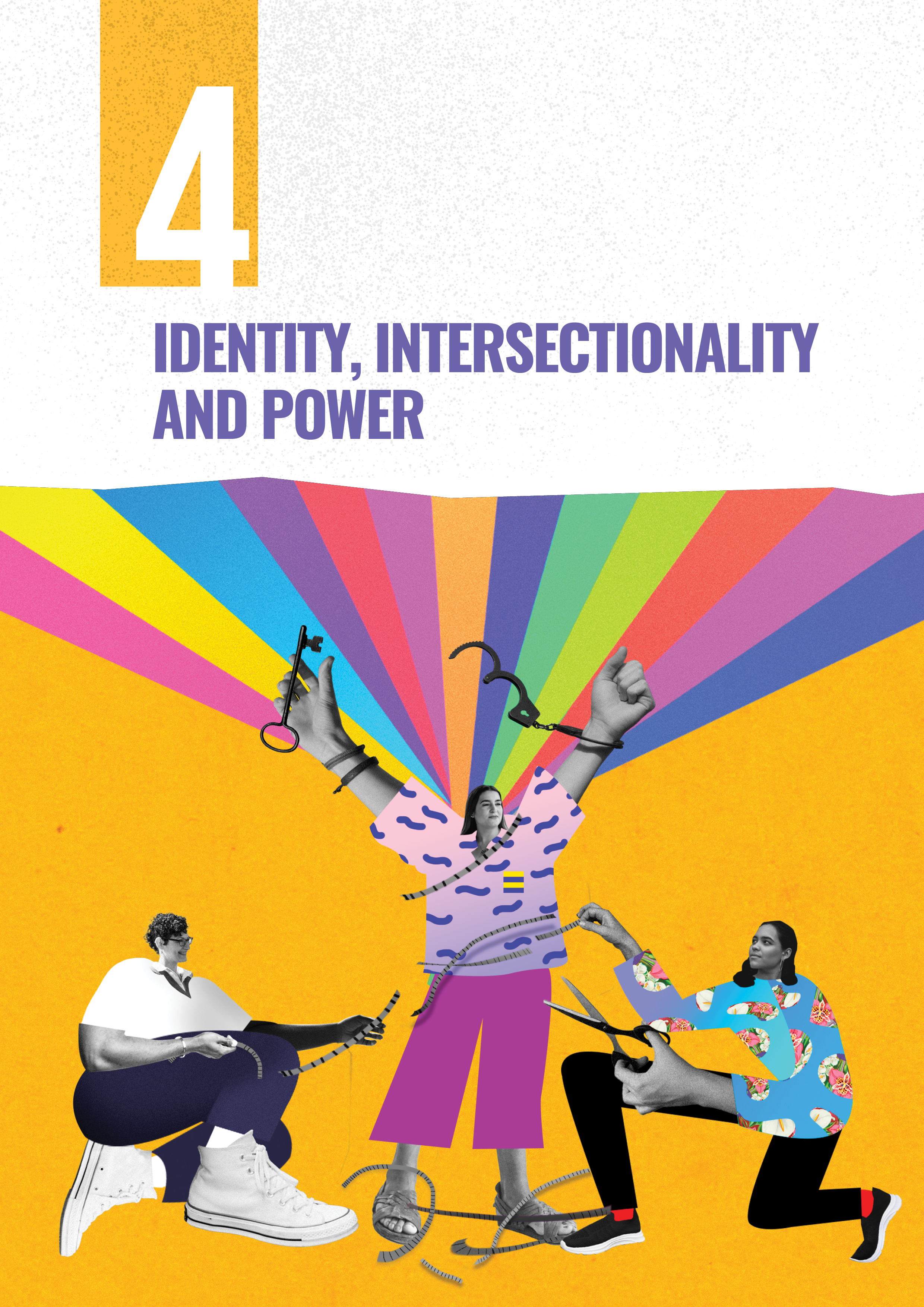Chapter 4: Identity, Intersectionality, and Power

Download this chapter A4 size or Letter size.

We can’t talk about power – especially from a decolonial feminist standpoint – without talking about how power intersects with identity, including the ways that:
- Dominant forms of systemic power embed inequity and structural violence in all aspects of life according to gender, race, ethnicity, class, sexuality and other factors of difference.
- Invisible power – norms and beliefs – normalise prejudice and discrimination.
- Elite and powerful groups are able to retain influence, legitimacy and decision-making power, and divide communities by mobilising prejudice and ‘othering’.
Questions of identity are essential to understanding, challenging, building, and transforming power. This chapter tracks the intersections of power with social identity, structures and systems. This understanding can help unleash the potential for liberation, solidarity and transformation.
Every one of us has multiple and complex identities related to our gender, class, race, ethnicity, religion, education, age, sexual orientation, ability, and other factors of difference. Intersectionality is one way of describing how these identities interact – within larger systems and structures – to shape different experiences of power, privilege, and oppression.
While our experiences of power vary greatly, we can find points of unity and common action if we take the time to understand each other’s experiences and work together for greater equity and justice. We can learn from one another, work together on solutions, and stand with each other.
The concept of intersectionality provides a helpful way for people to name their distinct experiences, claim their whole interconnected identity, and seek common ground with others. The idea is not new, but Kimberlé Crenshaw, an American legal scholar, coined the term in the 1980s, recognising that “intersectionality was a lived reality before it became a term”2 . She originally used the word to convey the dual reality of black women experiencing both gender and race discrimination.
Others who felt invisible within ‘women’s’ movements took up the term to bring to light the invisibility of many constituents within groups that claim them as members, but often fail to fully represent them. People of colour within LGBTQI+ movements; girls of colour in the fight against the school-to-prison pipeline; women within immigration movements; trans women within feminist movements; and people with disabilities fighting police abuse — all face vulnerabilities that reflect the intersections of racism, sexism, transphobia, ableism and more”3
In whatever way we choose to name our diverse and interconnected identities, it is our lived experience that matters. “It is important to name how various forms of violence interact and compound to affect different people in specific ways. For most, class, race, and gender are simultaneous forces…it is not ‘race + class + gender but ‘race X class X gender’.”4
Activist and writer Charlene Carruthers paraphrases the famous Combahee River Collective statement to explain why intersectional work is transformative: “[Because] if Black women were free, it would require the dismantling of so many systems of oppression that everybody else would be free as a result.”5
 This chapter explores three key themes and builds on the introduction to interconnected identities and power in Chapter 3. The historical timeline from Chapter 2 will be useful too.
This chapter explores three key themes and builds on the introduction to interconnected identities and power in Chapter 3. The historical timeline from Chapter 2 will be useful too.
Theme 1: Identity, Power, and Privilege
Who are we and how do we name and experience our different identities in our lives and in relation to other identities? Various identities – and their intersections – translate into widely differing degrees of power and privilege depending on context, history, and existing social structures and norms.
Theme 2: The Personal is Political
How do aspects of identity converge to compound and complicate power relationships? Links between identities and power can either aid or thwart the work for justice. For example, in certain contexts those with specific identities are targeted, stigmatised, and exposed to hostility and violence.
Theme 3: Identity, Power, and Transformation
Our identities link with the ways we can recover our power in different forms: power within – strength in re/claiming our whole self as valuable; power with – finding common ground with others who see us and share our issues and concerns; and power for and to – defining and working toward a vision of inclusive liberation where no part of us is left behind.
Together, the activities in these three sections deepen our understanding of power and identity – how they are experienced day-to-day in our families, relationships, organisations, work, community, and politics. We examine the ways in which risk and vulnerability are shaped by our social identities in different contexts, and the meanings they are assigned by the systems and structures of our society. And importantly, because power analysis aims to enable more powerful collaborative work for change, we show that by affirming and connecting our identities – with an intersectional lens – we can include our whole selves in ways that energise our communities and organisations, across apparent differences, in our strategies for liberation, justice, and safety.
_________________________________
1 Audre Lorde, Sister Outsider, Essays and Speeches, Berkeley : Crossing Press 2007
2 K. Crenshaw, the Washington Post, Sept 24, 2015 “Why Intersectionality Can’t Wait“.
3 K. Crenshaw, the Washington Post, Sept 24, 2015 “Why Intersectionality Can’t Wait“.
4 Ayesha Imam, UNFPA; Women in Nigeria; African Feminist Forum .
5 Charlene Carruthers, Unapologetic, Beacon Press, 2018.
